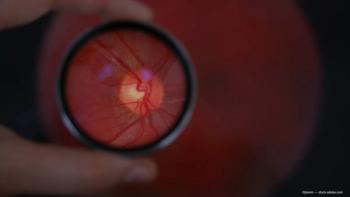
Kodiak Sciences releases follow-up, 20-week data from APEX study
Key Takeaways
- KSI-101 targets IL-6 and VEGF, showing potential as a cornerstone therapy for MESI with significant visual acuity gains and retinal drying.
- The APEX study's 20-week data revealed ≥90% of patients achieved absence of intraretinal and subretinal fluid.
The company describes KSI-101 as a “novel, potent, and high-strength (100 mg/mL) antibody-based investigational therapy with a bispecific mechanism of action targeting both interleukin-6 (IL-6) and vascular endothelial growth factor (VEGF).”
Kodiak Sciences has released follow-up, 20-week data from the APEX study of KSI-101 in patients with macular edema secondary to inflammation (MESI). The company describes KSI-101 as a “novel, potent, and high-strength (100 mg/mL) antibody-based investigational therapy with a bispecific mechanism of action targeting both interleukin-6 (IL-6) and vascular endothelial growth factor (VEGF).”
The APEX study evaluates KSI-101 in 2 cohorts, cohort 1 in patients with diabetic macular edema (DME) and cohort 2 in patients with MESI. It consists of 3 dosing levels: 2.5 mg (n=13), 5 mg (n=13), and 10 mg (n=13).
2.5 mg (n=13)
5 mg (n=13)
10 mg (n=13)
Proportion of patients with ≥15 letter gain
38%
62%
54%
Mean change in best corrected visual acuity (BCVA) from baseline to week 20 (ETDRS letters)
+11.8
+13.4
+15.4
Mean BCVA score achieved at week 20 (ETDRS leetters; Snellen equivalent)
74.5
~20/32
79.1
~20/25
79.0
~20/25
Mean change in retinal thickness
(OCT central subfield thickness) from baseline to week 20 (microns)
-151.2
-218.1
-230.1
Mean OCT CST achieved at week 20 (microns)
310.5
269.2
296.2
Earlier this year, the company released data demonstrating patients experiencing a clinically meaningful gain in best-corrected visual acuity (BCVA) and rapid retinal drying from baseline to week 12.
Victor Perlroth, MD, chairman and CEO of Kodiak, commented on the new data, saying, "These week 20 follow-up results suggest even more strongly the potential for KSI-101 to become a cornerstone therapy for the treatment of MESI. The data show that achieving complete retinal drying, meaningful visual acuity gains, and normalization of visual acuity is possible for most patients with MESI.”
“If confirmed in our Phase 3 studies PEAK and PINNACLE, KSI-101 may harmonize the MESI therapeutic landscape by becoming a safe, first-line unifying therapy for all causes of MESI,” concluded Perlroth.
Velazquez-Martin, MD, chief medical officer of Kodiak, commented on the results as well, saying, “Two key aspects of the extended data are very compelling and support our selection of the top two KSI-101 dose levels tested to move forward into our phase 3 program: achieving and sustaining real dryness as defined by the absence of intraretinal and subretinal fluid in more than ≥90% of the patients, as well as achieving an 'almost perfect' visual acuity at 20/25 Snellen equivalent. In addition, the fast onset of action across all three dose levels, with the vast majority of the drying effect already observed at Week 1, seems to be a clear differentiator."
The top 2 dose levels (5 mg and 10 mg) of KSI-101 were selected to advance to the PEAK (
References:
Follow-up data for Kodiak's KSI-101 from the APEX study showed continued strengthening of clinical effect (≥90% of patients achieving absence of intraretinal and subretinal fluid) through week 20 in macular edema secondary to inflammation (MESI). Published November 5, 2025. Accessed November 7, 2025.
https://ir.kodiak.com/news-releases/news-release-details/follow-data-kodiaks-ksi-101-apex-study-showed-continued Filkins K. Kodiak announces new data from APEX study of KSI-101. Published September 16, 2025. Accessed November 7, 2025.
https://www.ophthalmologytimes.com/view/kodiak-announces-new-data-from-apex-study-of-ksi-101
Newsletter
Don’t miss out—get Ophthalmology Times updates on the latest clinical advancements and expert interviews, straight to your inbox.









































